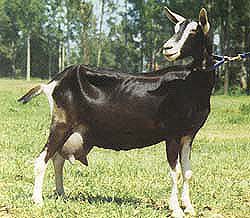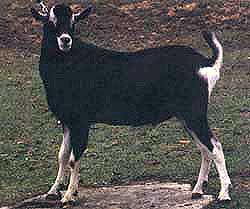
Goat breeds: British Alpine
Origin
The British Alpine breed was developed in Britain by crossing local goats with Alpine goats imported from Switzerland in 1903.
The first British Alpines were brought to Australia in 1958 but because of quarantine regulations the number was small. Further British Alpines have more recently been imported from New Zealand, however they were related to the animals first introduced so added little to the gene pool. Grading-up using Saanen and Toggenburg does is widely practised.
Breed characteristics
British Alpine does are medium to heavy milk producers. Fat yield is usually between 3% and 4%.
British Alpines are best suited to temperate climates, and are reported to perform poorly in areas of high humidity.
The British Alpine is a tall, rangy and graceful dairy-type animal (that is, with a dished or straight facial line and a wedge-shaped body). The average height, measured at the withers, is about 83 cm for does and 95 cm for bucks. The breed is similar to the Saanen in structure and the Toggenburg in markings.
British Alpines are black in colour and the coat is generally short, fine and glossy, although bucks may have longer hair. They have white or cream markings on various parts of the body. These markings may fade with age. Horns and tassels may or may not be present at birth. The ears are erect and point slightly forward. The muzzle is generally squarish. British Alpines are very independent and tend to stay with their own breed. They are excellent foragers and have good jumping ability.
The British Alpine doe

The high-producing British Alpine doe should also be an efficient reproducer. She should have a docile temperament and appear alert and feminine.
The udder should be well developed, not fleshy and have a collapsed appearance and a soft texture after milking. It should be round or globular, and not pendulous or ‘split’ between the halves. The udder should be carried high and well under the body. Good udder attachment is particularly important.
The teats should be distinct from the udder and moderately sized. They should be squarely placed and point slightly forward.
The jaw should be square (not overshot or undershot) and the teeth should be sound. The muzzle and nostrils should be wide, the lips broad and the eyes set well apart. The neck should be long, slim, of good depth, and connect evenly with the withers and shoulders.
The body should be wedge-shaped, well developed and have good height and depth. The ribs should be well sprung. The chest should be wide and deep, and the barrel deep and well rounded without tending to be fat. There should be no marked dip behind the withers or shoulders. The back should be level from the shoulders to the hips.
The British Alpine doe should stand and walk without dropping at the pasterns. The legs should be clean, long and straight, and placed squarely under the body. They should not be cow-hocked. The thighs should be thin, allowing adequate room for the udder.
The British Alpine buck

The British Alpine buck’s ability should be gauged by his reproductive performance and the quality and performance of his offspring.
The buck should have good conformation and depth of body, be masculine but not coarse in appearance and have vigour. He should not be heavily built.
The testicles should be of good size, well balanced, and firm. The scrotum should be well placed and allow the testes to hang away from the body (not excessively).
Polled bucks are not generally used in breeding programs as offspring resulting from matings with polled does may be either intersex females or sterile males. If polled bucks are used, they should only be mated with horned does.
Further information
For breed standards contact the Dairy Goat Society of Australia.

